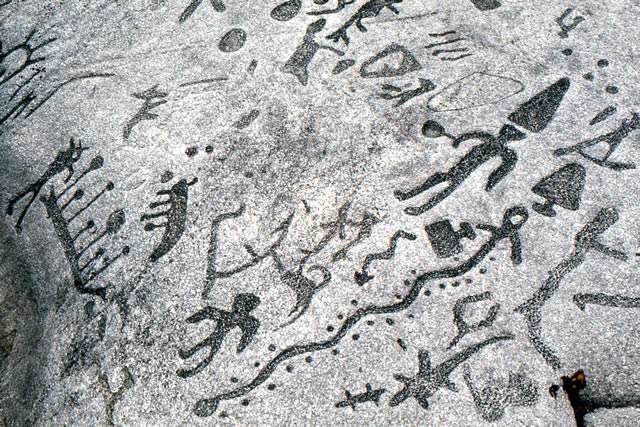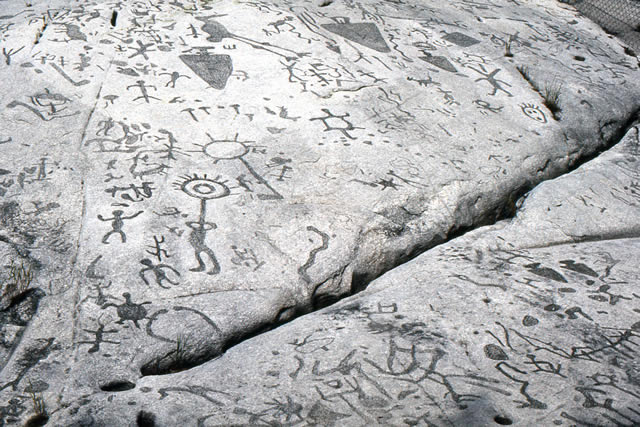Petroglyphs from Peterborough Provincial Park, Ontario, Canada
All photos are used with the permission of the photographer, Robin L. Lyke. These photos are of some very interesting and remarkable petroglyphs found near the town of Woodview northeast of Peterborough, Ontario. Petroglyphs are
ancient images that have been cut into a rock surface. They differ from Pictographs which are images painted on a rock surface. The wonderful
images on this page were taken in summer of 1970 even before the area was established as Petroglyphs Provincial Park (1976) and long before a huge glass enclosure was
built over the rocks to protect them from algae, frost and acid rain (1984). I was recently contacted by someone who had been a member of the Junior Ranger
Camp Program sponsored by the Ontario Government back in 1978. She stated that these work crews “carried our sledgehammers, crosscut saws, pick-axes,
spikes and shovels into that area daily, from the main road, to clear the beaver dams, drain the swamps, cut the trees, and carry the logs on our shoulders
to build the paths through the bogs so that, in future years, visitors could see the rock outcropping.”
The gleaming white limestone slab at Peterborough is generally believed to have been carved by the native Algonquin and other First Nations peoples
between 900 and 1400 AD. The mammoth stone outcropping is a rough rectangle measuring nearly 100 feet by 180 feet. The Algonquin people were the latest
artists but some of the carvings seem out of place and closely resemble ancient art found in Scandinavia. Additionally, two images closely resemble the hunchback figure
of a Hopi kachina flute player named Kokopelli and may be attributable to ancient migrating Hopi travelers. This is the largest known concentration
of Aboriginal rock carvings in Canada (and probably North America) with over 900 petroglyphs. Over 300 of the carvings are very distinct and depict turtles,
snakes, birds, humans and other images including the figure of the Algonquin shamen. The local Anishnawbe people and other native Algonquin tribes of Ontario call the rock slab Kinomagewapkong, meaning "the rocks that teach”. The
Native people see these rock carvings as a written Bible and as the source of their spiritual wisdom. The Native American shamans would have conducted
rituals at the site. The beautiful and peaceful area is a sacred, holy place, where you could go to enter into the spirit world and has been used by
various cultures for thousands of years as an “outdoor cathedral”. A fissure in the rock may have been revered as the symbolic womb of the Earth Mother.
There is an intermittent underground stream that, when the water level is high, causes sounds to burble up through the rocks. These sounds often imitate
human voices and Native people believed this was the "Voice of the Spirits" speaking to them. When you heard this, they believed the spirits
were trying to tell you some wisdom. It was a place the holy spirits could speak to them but, since the protective glass enclosure was built over the
area, these voices are no longer heard. The Peterborough Petroglyphs were discovered by historian Charles Kingam in 1924 but the importance was forgotten again until 1954, when it was
accidentally “rediscovered” by miners of the Industrial Minerals of Canada searching for appropriate ore to use in manufacturing “bubble less” glass.
Archeologists reportedly found 31 hammer-stones, and 7 pieces of pottery between the crevices of the rocks but they couldn't explain why there were no
other signs of habitation, or "detritus" around. Native people will point out that this is to be expected as their ancestors would never have left garbage at their “holy” place. Although the native tribes are confident that their ancestors created these beautiful carvings there are several other theories of their creation. A Harvard professor believes the petroglyphs are inscriptions (and maybe even a form of written language) left by a Norse king named
Woden-lithi (Servant of Odin), who was believed to have sailed from Norway down the St. Lawrence River in about 1700 B.C., long before the Greenland Viking
explorations. Another Mayanologist claims the symbols could be European and may date to 1000 B.C. According to a third, the petroglyphs are a sky map of
the heavens based on European tradition from c.3117 B.C.. There are plenty of people on the Internet that support the view that the carvings have nothing to do with Native American traditions but the Algonquin
people are firm in their beliefs. Whether these carvings are less than 1000 years old or over 5000 years old they are an intriguing artwork of remarkable beauty. For more information and a great analysis of the petroglyphs and thoughts on their origin visit Peter
Albinger's wonderful blog. Also,for a wonderful film that gives an in-depth insight into the carvings and their meanings to the Ojibwa tribe follow this link to The Teaching Rocks by Lloyd Walton.
Enjoy the images, below, and make your own interpretation.
 |
 |
 |
 |
 |
 |
 |
 |
 |
 |
 |
 |
 |
 |
An excellent article from the October 27, 1962 Milwaukee Sentinal
Notice the girl sitting on the ledge - The petroglyphs cover a VERY large area.
________________*********_________________
THIS IS THE FINE PRINT